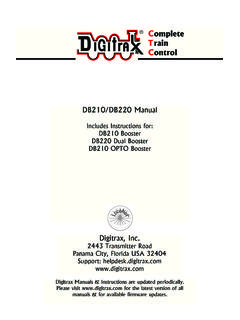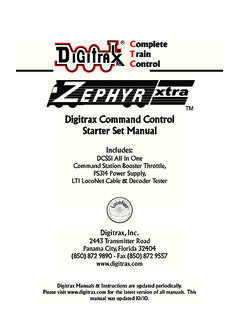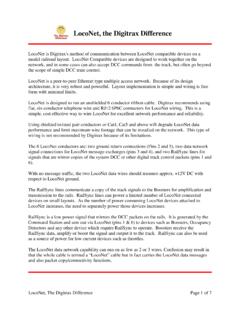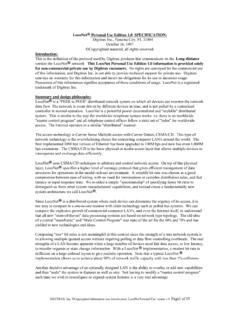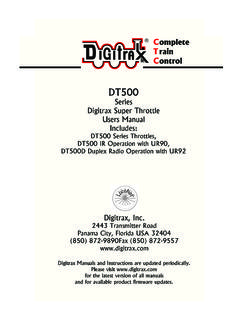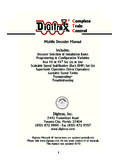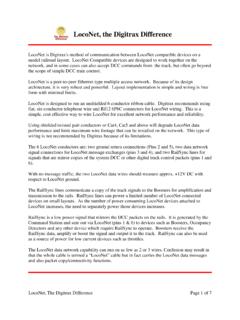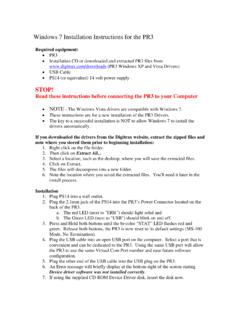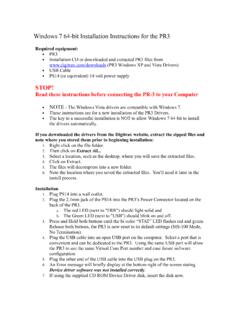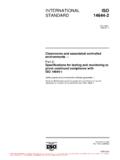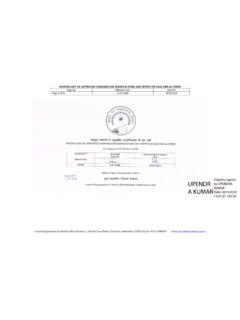Transcription of LocoNet - Digitrax
1 Digitrax Inc, Copyrighted information (see introduction): LocoNet Personal Use version Page1 of 15 LocoNet Personal Use Edition specification : Digitrax Inc., Panama City, FL 32404 October 16, 1997 Copyrighted material, all rights :This is the definition of the protocol used by Digitrax products that communicate on the Long distanceversion the LocoNet network. This LocoNet Personal Use Edition information is provided solelyfor non-commercial private use by Digitrax customers. No rights are conveyed for the commercial useof this information, and Digitrax Inc.
2 Is not able to provide technical support for private use. Digitraxconveys no warranty for this information and incurs no obligations for its use or incorrect of this information signifies acceptance of these conditions of usage. LocoNet is a registeredtrademark of Digitrax and design philosophy: LocoNet is a "PEER to PEER" distributed network system on which all devices can monitor the networkdata flow. The network is event driven by different devices in time, and is not polled by a centralizedcontroller in normal operation. LocoNet is a powerful power decentralized and "scalable" distributedsystem.
3 This is similar to the way the worldwide telephone system works- there is no worldwide"master control program" and all telephone central offices follow a strict set of "rules" for worldwideaccess. The Internet operates in a similar "distributed access technology is Carrier Sense Multiple access with Carrier Detect, CSMA/CD. This type ofnetwork technology is the overwhelming choice for connecting computer LAN's around the world. Thefirst implemented 10M bps version of Ethernet has been upgraded to 100M bps and now has even 1,000 Mbps extensions. The CSMA/CD is the basic physical or media access layer that allows multiple devices tointeroperate and exchange data uses CSMA/CD techniques to arbitrate and control network access.
4 On top of this physicallayer, LocoNet specifies a higher level of message protocol that gives efficient management of datastructures for operations in the model railroad environment. A sensible bit rate was chosen as a goodcompromise between ease of wiring, with no need for terminations or complex distribution rules, and fastlatency or rapid response time. We avoided a simple "specsmanship" of specifying faster bit rates todistinguish us from other system manufacturers' capabilities, and instead chose a fundamentally newsystem architecture we call LocoNet .
5 Since LocoNet is a distributed system where each device can determine the urgency of its access, it isnot easy to compare in a one-to-one manner with older technology such as polled bus systems. We cancompare the explosive growth of commercial computer LAN's, and even the Internet itself, to understandthat all new "state-of-the-art" data processing systems are based on network type topology. The old ideaof a central "mainframe" and "Main Control Program" was state of the art for the 60's and 70's and hasyielded to new technologies and "raw" bit rates is not meaningful in this context since the strength of a true network system isin allowing multiple queued access without requiring polling or data flow controlling overheads.
6 The realstrengths of a LAN become apparent when a large number of devices need fast data access, or low latency,to transfer requests or state change information. With a LocoNet implementation, a modest bit rate issufficient on a large railroad layout to give realistic operation. Note that a typical LocoNet implementation allows us to achieve about 98% of network traffic capacity with less than 1% decisive advantage of an optimally designed LAN is the ability to overlay or add new capabilitiesand thus "scale" the system in features as well as size. Not having to modify a "master control program"each time we wish to reconfigure or expand system features is a very real Inc, Copyrighted information (see introduction): LocoNet Personal Use version Page2 of 15An example of this is the way the Digitrax "Big Boy" can be expanded with DT100's and get a network"fast clock", even though the DT200 master did not itself support this.
7 The soon to be released DigitraxTetherless throttles (both Radio and IR) can take advantage of the network environment to add a numberof different types of features among many interfaces on the same LocoNet network. LocoNet isconfigured to allow all types of data traffic to flow on a single wiring scheme. This means you do nothave to run separate Throttle, Booster, Feedback and PC wiring for the system. Since LocoNet is basedon LAN technology, a large LocoNet layout can use Bridging , Routing and Fault isolation techniquesas used on commercial networks to expand to a large physical allow the addition of multiple independently operating PC's around a large physical layout usingsimple access hardware, the LocoNet was "slowed down" and simplified somewhat over a "rawhardware" driven system capability.
8 This trade off was made to ensure ease of attachment of PC's, and weat Digitrax feel that once the power of "computer assisted modeling" was appreciated, a single PC wouldrapidly prove inadequate, as task complexity and demands increased. Also, we feel it is important that PCtasks can be independent, modular and spread out among many different PC's around the layout. Inparticular being able to use slower old "AT" 286's and 386's running DOS and Windows etc., wasimportant, since requiring a dedicated new "Wintel PC" costing over US$2,000 seems like a veryexpensive proposition for what is essentially a hobby!
9 technical specification :The normal LocoNet state is IDLE, with no data traffic unless a device has information to send. With notraffic flow, the network is RFI :The full implementation of LocoNet uses a 6 pin USOC RJ12 style TELCO connector. Thenetwork is designed to operate "daisy chained" on unterminated 26 AWG 3 pair cable or flat 6 conductortype 120 ohm impedance ribbon cable. It can be cabled in numerous variations. It is designed to betolerant of cabling environment. It is permissible for the individual wires to loop back on themselves,noting that the 2 Rail_sync lines are of opposite phase and cannot be connected.
10 The connections arebalanced to minimize RFI. The connections may be branched in any combination to yield a "Star" or"Bus" or any combination thereof. Only a single LocoNet current termination is needed and is typicallysupplied by the system "Master".Pinouts for the RJ11/6 connector are:1-RAIL_SYNC-white2-SIGNAL GROUND3- LocoNet -4- LocoNet +5-SIGNAL GROUND6-RAIL_SYNC+blueUsing typical UL6010 6 conductor 26 AWG Telephone flat ribbon cable, a network may typicallyhave a total parallel cable length of up to 2,000', with no point-to-point length exceeding 1000'. This isusing the "standard" Long Distance LocoNet termination of a 15 milliamp positive current source onpins 3 and 4 of the connectors.

